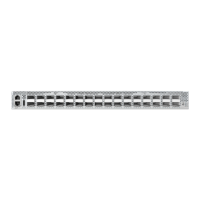C
HAPTER
1
| Introduction
Description of Software Features
– 58 –
DESCRIPTION OF SOFTWARE FEATURES
The switch provides a wide range of advanced performance enhancing
features. Flow control eliminates the loss of packets due to bottlenecks
caused by port saturation. Broadcast storm suppression prevents
broadcast traffic storms from engulfing the network. Untagged (port-
based), tagged, and protocol-based VLANs, plus support for automatic
GVRP VLAN registration provide traffic security and efficient use of network
bandwidth. CoS priority queueing ensures the minimum delay for moving
real-time multimedia data across the network. While multicast filtering and
routing provides support for real-time network applications.
Some of the management features are briefly described below.
CONFIGURATION
BACKUP AND
RESTORE
You can save the current configuration settings to a file on the
management station (using the web interface) or a FTP/TFTP server (using
the console interface), and later download this file to restore the switch
configuration settings.
AUTHENTICATION This switch authenticates management access via the console port, Telnet,
or a web browser. User names and passwords can be configured locally or
can be verified via a remote authentication server (i.e., RADIUS or
IEEE 802.1D Bridge Supports dynamic data switching and addresses learning
Store-and-Forward
Switching
Supported to ensure wire-speed switching while eliminating bad
frames
Spanning Tree Algorithm Supports standard STP, Rapid Spanning Tree Protocol (RSTP),
and Multiple Spanning Trees (MSTP)
Virtual LANs Up to 256 using IEEE 802.1Q, port-based, protocol-based, private
VLANs, voice VLANs, and QinQ tunnel
Traffic Prioritization Default port priority, traffic class map, queue scheduling, IP
Precedence, or Differentiated Services Code Point (DSCP), and
TCP/UDP Port
Qualify of Service Supports Differentiated Services (DiffServ)
Link Layer Discovery
Protocol
Used to discover basic information about neighboring devices
Router Redundancy Router backup is provided with the Virtual Router Redundancy
Protocol (VRRP)
IP Routing Routing Information Protocol (RIP), Open Shortest Path First
(OSPF), static routes, Equal-Cost Multipath Routing (ECMP)
ARP Static and dynamic address configuration, proxy ARP
Multicast Filtering Supports IGMP snooping and query for Layer 2, and IGMP for
Layer 3, and Multicast VLAN Registration
Multicast Routing Supports PIM-DM and PIM-SM
Table 1: Key Features (Continued)
Feature Description

